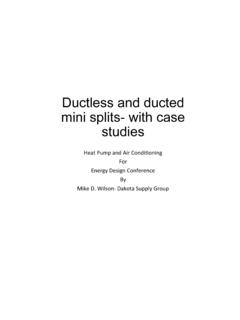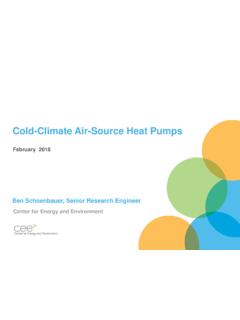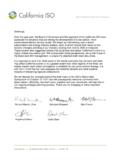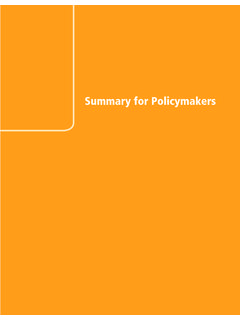Transcription of CO2-based Demand Controlled Ventilation (DCV)
1 CO2-based Demand Controlled Ventilation (DCV) The same way it was in 1930. With Fixed Ventilation ! How is Ventilation provided in buildings today? Ventilation Control!Minimum Ventilation Rates Inefficient! building codes require Ventilation rates based on cfm/person: (typically 20 cfm/person) Max Occupancy: 25 people = 500cfm Actual Occupancy: 5 people = 500cfm Actual Occupancy: 1 person = 500cfm Fixed Ventilation Controlling Ventilation There is a clearly defined relationship between indoor CO2 levels & Ventilation rates established by: Indoor CO2 levels are a measure of Ventilation rates (cfm/person) CO2 levels are not a measure of overall IAQ. ASHRAE & ASTM CO2 & Ventilation Standard CO2 is the control parameter for Ventilation !!Indoor Air Quality FIRST ALARM (TWA) SECOND ALARM (STEL) SENSOR LOCATION RADIUS OF DETECTION Temperature & Humidity N/A N/A N/A N/A Carbon Dioxide (CO2) 800-1200 ppm 5000 ppm 5 ft.
2 Above floor 20 ft. Oxygen (O2) (O2 depletion) 22% (O2 saturation) CO2 Basics CO2 is NOT a contaminant, it is a colorless, odorless gas found naturally in the atmosphere! Outdoor levels are fairly constant at 400 +/- 25 ppm! Typical indoor levels 400 to 2,500 ppm! Not harmful unless concentrations reach 30,000 ppm ! Carbon Monoxide (CO) and Carbon Dioxide are NOT the Same!People exhale CO2 at concentrations of 4% (40,000 ppm) Normal room concentrations are in the range of 400 - 1200 ppm As a gas, CO2 diffuses and equalizes rapidly throughout a room (like humidity) CO2 Basics CO2 production by people is very predictable based on activity level Doubling the people in a room will double CO2 production CO2 and Ventilation Rates -5001,0001,5002,0002,5003,0000:001:002:0 03:004:005:00 Time (hours)CO2 Concentrations (ppm)30 cfm/p erson20 cfm/p erson15 cfm/p erson10 cfm/p erson5 cfm p er p erson5 cfm/person 10 cfm/person 15 cfm/person 20 cfm/person 30 cfm/person CO2 levels will build until an equilibrium level is reached with outside air entering the space CO2 and Ventilation Rates Actual Occupancy 25 people = 500cfm Actual Occupancy 5 people = 100cfm Actual Occupancy 1 person = 20cfm Ventilation based on actual occupancy!
3 Ventilation Control!DOE/Lawrence Berkeley Labs!Indoor Environment In Schools!Pupils Health & Performance In Regard To CO2 Concentrations"A significant correlation was found between decreased performance and high CO2 levels (lower Ventilation rates).! Increases Productivity Improves Occupant/Customer Satisfaction Helps Prevent Sick building Syndrome Health Affects Numerous Studies Confirm that Correct Ventilation : Research & Studies! Air Quality and Ventilation !ranked very high (#2 of 25) on the list !of tenant retention issues !in a recent survey conducted by !Real Estate Information Systems. !Research & Studies Increases Productivity Improves Occupant/Customer Satisfaction Helps Prevent Sick building Syndrome Health Affects Numerous Studies Confirm that Correct Ventilation : DOE/Lawrence Berkeley Labs Evaluation of !Sick Leave Statistics vs.
4 Ventilation Rates! (3720 employees / 40 buildings):!Optimal Ventilation reduces sick time costs. For every $1 spent on Ventilation cost, !$2 are saved in sick time.!Research & Studies Increases Productivity Improves Occupant/Customer Satisfaction Helps Prevent Sick building Syndrome Health Affects Numerous Studies Confirm that Correct Ventilation : Research & Studies Status of American Schools l 60 million Americans go to school (staff & student) l 14 million students in schools considered below standard or dangerous l 15,000 Schools have indoor air quality that is unfit to breathe l Students and faculty typically spend 85-90% of their time indoors (mostly at home and school) l Concentration of pollutants indoors is typically higher than outdoors, sometimes by as much as 10 or even 100 times Source: A Report for the Massachusetts Technology Collaborative - November 2005 Research & Studies School Study Measured performance vs.
5 Temperature and outdoor air intake variations Temperature and Ventilation were varied independently to gather data Outcome Increasing OA intake and decreasing temperature both improved speed Increasing OA intake and decreasing temperature did not improve error rate ASHRAE Journal, October 2006 Proof of Compliance Using CO2-based Ventilation control ensures compliance to codes and standards! Benefits of Ventilation Control Now Allowed by Most Mechanical Codes International Mechanical code (IMC) Local Codes ASHRAE Standard ASHRAE Written into the actual standard since ASHRAE 62-2004 Now Allowed by Most Mechanical Codes Commentary To The International Mechanical code (IMC) Section The intent of this section is to allow the rate of Ventilation to modulate in proportion to the number of occupants. This can result in significant energy savings.
6 Current technology can permit the design of Ventilation systems that are capable of detecting the occupant load of the space and automatically adjusting the Ventilation rate accordingly. For example, carbon dioxide (CO2) detectors can be used to sense the level of CO2 concentrations which are indicative of the number of occupants. People emit predictable quantities of CO2 for any given activity, and this knowledge can be used to estimate the occupant load in a space. Was written into the actual code for IMC 2006 Now Allowed by Most Mechanical Codes Wisconsin Ventilation code 2011 Based on IMC 2009 With about 10 pages of amendments Wisconsin Implementation Trends Demand Control Ventilation (DCV) Chicago Ventilation code since 2003 Demand Ventilation . The amount of outside air delivered by a mechanical supply system may be reduced during operation below the quantities listed in able if the system is capable of measuring and maintaining CO2 levels in occupied spaces no greater than 1000 ppm.
7 The system capacity shall be greater than or equal to the ordinance requirements. Proof of Compliance Also required in green codes such as ASHRAE , IgCC, and LEED! Benefits of Ventilation Control Now Required by Most Energy Codes International Energy Conservation code (IECC) Local Codes ASHRAE Standard IECC 2012 ( code in 13 states) requires DCV at population densities of 25 people per 1000 ft2 IECC 2009 (WI and 28 other states) requires DCV at 40 people per 1000 ft2 DCV Now Required by Most Codes Chart compares Ventilation usage throughout typical day using purple to represent Demand Controlled and green to represent constant Difference between equates to significant savings DCV Savings Federal Energy Management Program Study 0%10%20%30%40%50%60%70%80%90%100%OfficeR etailRestaurantSchoolResearch Findings Demand Control Ventilation Energy required, DCV control applied HUGE Savings Energy wasted - no DCV SCHOOL!
8 $6,910!Annual Savings!15 mo. ROI THEATRE!$11,530!Annual Savings!8 mo. ROI!SCHOOL!$20,051!Annual Savings!18 mo. ROI!THEATRE!$17,603!Annual Savings!7 mo. ROI!RETAIL!$18,729!Annual Savings!5 mo. ROI!OFFICES!$7,112!Annual Savings!12 mo. ROI!OFFICES!$3,448!Annual Savings!15 mo. ROI!Examples of Potential Energy Savings and ROI 2004 FEMP Study 4 CO2 sensors per floor Energy Model l $81,293 annually l $3,000 per floor l $ Actual saving for 6 months was $133,805 FEMP Study Who Is Using DCV? School, MN Manufacturer, WI Office, MN University, IN Early Adopters (1990s) - Midwest Drivers Comfort/Productivity Need For Quick Response To Complaints Results Problem areas identified and corrected quickly (over and under Ventilation ). Teacher concerns resolved quickly. Red Wing School District, MN Drivers Energy Savings Tenant Comfort/Satisfaction Results Significant reduction in heating and cooling costs ($200k 1st year) 3 month ROI LaSalle Plaza, MN Drivers Energy Savings Productivity/Learning Low Maintenance Solution Results The installation provided a 1 to 2 year payback (Luci Keazer, Controls Engineer) Purdue University, IN Drivers Productivity Comfort Total Quality Environment Results An Important part of Harley s Quality Program for a comfortable and productive work environment.
9 Harley Davidson, WI 2014 Wisconsin Case Study Feasibility study to determine savings potential with DCV strategy: Monitored store for a week with CO2 monitors Compared against usage history 20-30% gas usage reduction was estimated Cost to implement $7,000 floor space considered a single zone Payback around 8 months with incentives Other interesting findings Applica tionRatingApplica tionRatingApplica tionRatingCorrectional facilitiesSpe cialty s hopsHo s p it als an d m e d ical facilitiesCellsABarber and beautyBPa t ie n t r o o msBDining halls ( Note 2)BReduc ing s alonsBMe d ic a l p r o c e d u r eCGuard s tationsCFlor is tsBOperating roomsCDr y cle an e r s an d lau n d r ie sClothier sBRec ov er y and ICUBC ommer c ial laundr yBFur nitur eBAutopsy roomsCCommer c ial dr y - c leanerCHar dw ar e BPh y s ic a l t h e r a p yAStorage and pickupBSupermarketsBLobbies and w aiting areasACoin- oper ated laundr iesAPe t s h o p sCHo t e ls , r e s o r t s an d dorm itoriesCoin- oper ated dr y cleanersCSpor ts and am us e m e ntBedroomsBEd u c a t i o n a n d s c h o o l s Spectator areasALobbiesAClas s r oomsAIndus trial facilitie sConf er enc e r oomsALaboratories (Note 4)
10 BHeav y manuf ac tur ingCMe e t in g r o o msATr aining s hopsBLight manuf acturingBBallrooms and assembly areasAMu s ic r o o msAMa t e r ia ls s t o r a g eCGambling c as inoBLibrariesATr aining f ac ilitiesCGame roomsALocker roomsCPa in t in g a n d f in is h in g areasCIc e a r e n a sAAuditoriumsAFood and meat pr oc es s ingCSw imming poolsCSmoking lounges (Note 3)BOffice buildingsAGy mnas iumsAFo o d an d b e ve r ag e s e r vice Re t ail s t o r e sBallrooms and discosADining r ooms ( Note 2)BSales f loorsABow ling alleysACaf eter ias ( Note 2)BDr es s ing r oomsATheatersABars, cocktail lounges (Note 3)BMa lls a n d a r c a d e sATransportationKitchensCShipping and receivingCWaiting roomsAGar age s , r e pair and s e r vice stationsCWarehousesCPla t f o r msARating Legend: A Recommended B Possible (Note 1) C Not RecommendedDetermine if CO2 Control is Appropriate Control Setpoints!










